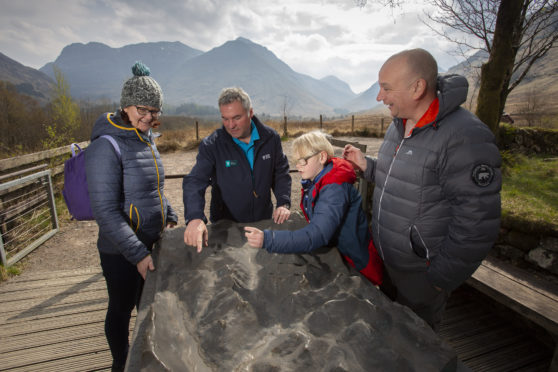Archaeologists are to excavate three forgotten villages of Glencoe whose structures have long disappeared beneath a blanket of grass and heather.
The three townships of Inverigan, Achnacon and Achtriochtan, vanished during the clearances when their people were scattered to the four winds.
Now the National Trust for Scotland wants to bring the secret history of the area back to life by uncovering the homes and their stories.
It hopes to offer fresh insight into life in the glen during the 17th century and, in addition to excavations, also intends to recreate two turf homes.
The project is expected to cost in the region of £300,000 and fundraising efforts are already underway.
Historian Neil Oliver, who is the president of the National Trust for Scotland, praised the ambition displayed to bring the project to fruition.
He said: “Never before has this type of work been carried out at Glencoe.
“We now need to raise £300,000 to bring this project to life.
“This will support our archaeological work and enable us to recreate two turf houses, using traditional methods and materials wherever possible.
“We need the public’s help to do that and as a charity, we rely on donations to help us share the stories of iconic places like Glencoe.
“With your support, we can bring alive the sights, smells and sounds of the 17th century and help us to remember those who lost their lives in the troubled times that shaped Scotland’s history.
“This project will also help us celebrate the resilience of the Highlanders and their way of life, now and for generations to come.”
The people of the three townships – and many others – were forcibly evicted from their homes and land during the 18th and 19th century.
The clearances scattered large proportions of the Highland population.
Some were offered new land – much of it poor, precarious and of little value for habitation or food – while others were simply thrown out.
Many started new lives overseas.
The lost villages project will deliver an insight into life before those clearances and tell more about the people who lived in the area.
Achtriochtan, which is now entirely covered by grass, scree and heather, is understood to have been home to around 60 people back in 1692.
The project comes on the back of the £1 million refurbishment of the Glencoe Visitor Centre,
It’s doors reopened in May and it now provides visitors with an immersive learning experience, telling the story of the history and wildlife of the Glencoe area.
Simon Skinner, chief executive of the National Trust for Scotland, added: “It has been an exciting year for Glencoe, one of the most significant and spectacular treasures cared for by the National Trust for Scotland and which is known the world over for its outstanding beauty.
“We have invested heavily in telling the area’s incredible story and the new centre has been very well received by visitors.
“The glen attracts thousands of people every year from all over the world and this latest project is an opportunity to share even more of its history.”
Last year, more than 210,000 people visited the Glencoe Visitor Centre.
The latest project is part of the conservation charity’s five-year plan to enrich Scotland’s built and natural heritage.
The Massacre of Glencoe
The Massacre of Glencoe took place on February 13, 1692, and continues to hold an important place in the Scottish national psyche.
The Scottish clans had remained loyal to King James II after he was replaced by William of Orange (William III) on the English and Scottish thrones in 1689.
The rub came when the government offered indemnity to all chiefs to changes sides and swear allegiance to William by January 1, 1692.
Anticipating problems, the government issued ‘letters of fire and sword’ authorising merciless attacks on those who refused- and most of the chiefs took the oath.
But Alexander MacDonald of Glencoe left his submission to the very last minute, December 31 1691, and then found himself unable to take his oath until January 6 due to the lack of a magistrate in Fort William to receive it.
No such things as cutting a bit of slack in those days – Sir John Dalrymple, William’s secretary of state for Scotland immediately issued an order under the king’s signature for the military punishment of the MacDonalds.
Soldiers led by Archibald Campbell, 10th Earl of Argyll, turned on members of the Glencoe MacDonald clan and massacred 38 people.
What made the attack so notorious was that around 100 of Argyll’s soldiers had been billeted with the MacDonalds in a form of taxation known as ‘free quarter.’
Many of the clan escaped, but the chief, 33 other men, two women, and two children were killed.
John Campbell, earl of Breadalbane and Holland, a neighbour and an enemy of the MacDonalds was widely suspected of planning the attack but historians say he was not its main instigator.
He was imprisoned in 1695, but that was for earlier involvement with the Jacobites.
The massacre is now commemorated on its annual anniversary with the Clan Donald Society holding a wreath-laying ceremony attended by members from around the world at the Upper Carnoch memorial.
